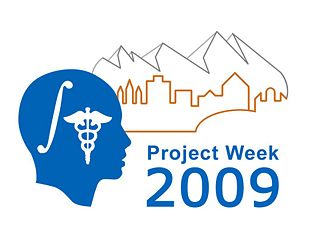Difference between revisions of "2009 Winter Project Week Hageman UCLANSBrainLab"
(New page: {| |thumb|320px|Return to [[2009_Winter_Project_Week|Project Week Main Page ]] |[[Image:Hageman_cspfig4NAMIC_07-06-22.png|thumb|320px|Corticospinal tracts segmented...) |
|||
| Line 1: | Line 1: | ||
{| | {| | ||
|[[Image:NAMIC-SLC.jpg|thumb|320px|Return to [[2009_Winter_Project_Week|Project Week Main Page]] ]] | |[[Image:NAMIC-SLC.jpg|thumb|320px|Return to [[2009_Winter_Project_Week|Project Week Main Page]] ]] | ||
| − | |||
| − | |||
|} | |} | ||
| Line 19: | Line 17: | ||
<h1>Objective</h1> | <h1>Objective</h1> | ||
| − | + | Preoperative mapping of the brain is an important step in tumor resection involving functionally critical areas of the brain. Visualization of the location of gray and white matter structures with respect to the tumor mass helps the surgeon plan an operative approach that will minimize post-operative deficits. While functional areas have successfully been localized via fMRI, recently diffusion tensor imaging (DTI) has been shown to be successful in localizing critical white matter structures. The neurosurgery department at UCLA has been using BrainLab to do this type of preoperative planning in tumor patients. The recent link of BrainLab to Slicer allows us to take advantage of the alogithms in Slicer in the clinical research setting. The goal of this project is to develop a successful link between BrainLab and Slicer for the UCLA neurosugery department to assist in preoperative planning of tumor resection. | |
| − | |||
| − | |||
</div> | </div> | ||
| Line 29: | Line 25: | ||
<h1>Approach, Plan</h1> | <h1>Approach, Plan</h1> | ||
| − | |||
| − | |||
| − | |||
| − | |||
| − | |||
| − | |||
| − | |||
| − | |||
| − | |||
| − | |||
| − | |||
</div> | </div> | ||
| Line 45: | Line 30: | ||
<h1>Progress</h1> | <h1>Progress</h1> | ||
| − | |||
| − | |||
| − | |||
</div> | </div> | ||
| Line 56: | Line 38: | ||
===References=== | ===References=== | ||
| − | |||
| − | |||
| − | |||
Revision as of 13:16, 18 December 2008
Home < 2009 Winter Project Week Hageman UCLANSBrainLab Return to Project Week Main Page |
Key Investigators
- UCLA: Nathan Hageman
- UCLA: Arthur Toga, Ph.D
Objective
Preoperative mapping of the brain is an important step in tumor resection involving functionally critical areas of the brain. Visualization of the location of gray and white matter structures with respect to the tumor mass helps the surgeon plan an operative approach that will minimize post-operative deficits. While functional areas have successfully been localized via fMRI, recently diffusion tensor imaging (DTI) has been shown to be successful in localizing critical white matter structures. The neurosurgery department at UCLA has been using BrainLab to do this type of preoperative planning in tumor patients. The recent link of BrainLab to Slicer allows us to take advantage of the alogithms in Slicer in the clinical research setting. The goal of this project is to develop a successful link between BrainLab and Slicer for the UCLA neurosugery department to assist in preoperative planning of tumor resection.
Approach, Plan
Progress